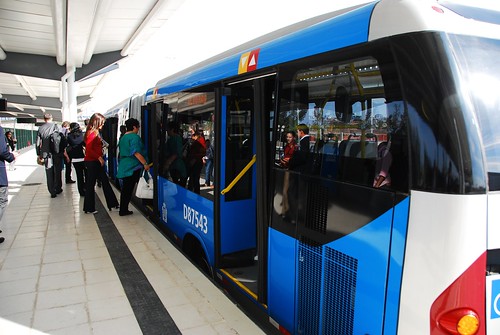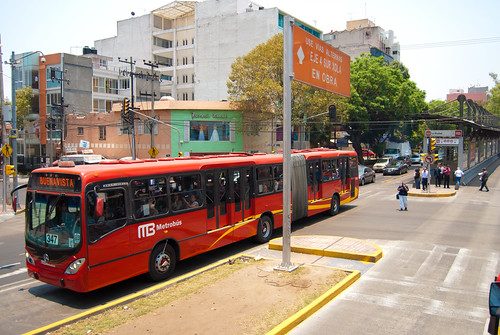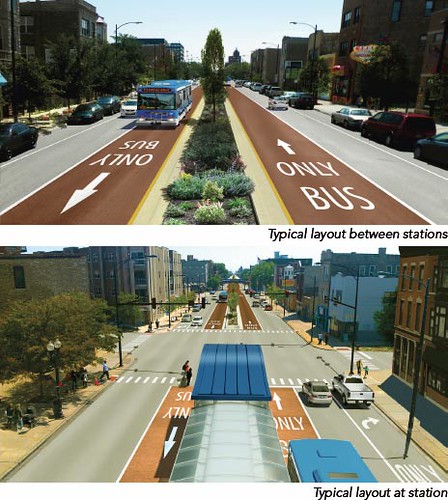There’s a new global benchmark for rating bus rapid transit projects. Today the Institute for Transportation and Development Policy released the BRT Standard 2013, which lays out the requirements for bus routes to qualify as BRT and scores 50 systems in 35 cities around the world as basic, bronze, silver, or gold based on various criteria. The idea, which ITDP has been refining since a beta release in 2011, is to provide a concrete definition of what BRT is, and a reference for politicians, planners, and advocates who are interested in creating new BRT routes, as well as to rate the quality of existing systems.
The standard rates more than 30 aspects of bus corridor design, awarding points for elements that improve system performance. Dedicated bus lanes, level boarding, pre-paid boarding and signal prioritization are considered basic requirements for BRT. Additional elements that score points include multiple bus routes running on the same corridor; passing lanes at stations; low-emission buses; attractive, weather-protected stations; real-time arrival info signs; integration with bike sharing and more.
Streetsblog recently caught up with ITDP CEO Walter Hook via telephone to get more info on the new guide.
John Greenfield: Congratulations on releasing the BRT Standard. So this is kind of like the LEED [green building rating system] for bus rapid transit, correct?
Walter Hook: Yeah, that’s basically the idea, with the additional caveat that the BRT Standard is also positing a minimum definition for what constitutes BRT at all, which is not really an element in LEED. I mean, LEED doesn’t say, “You’re not a green building if you don’t hit any of these things.” The BRT Standard now has a minimum definition. That’s new from last time.
JG: What is your minimum standard for something to be called BRT?
WH: It’s a fairly complicated formula but essentially it has to have a dedicated lane of at least four kilometers. If it’s on a two-way road, it has to run along the central median. If it’s a curb-running bus lane on a two-way street it’s pretty much ineligible. So there are a couple of baseline things, but there are a lot of details and nuances.
And then you need to score a certain minimum number of points on BRT basics, which means it has to have at least some of the following elements like off-board fare collection, certain treatments at intersections, and other things that we consider to be pretty much essential.
JG: So the United States has a few different bus services that got a bronze rating. Does that mean that those are all considered to be BRT?
WH: Yeah, if you scored bronze and we say you’re BRT, then you’re BRT.
JG: Why do you think it was important to create a standard for BRT?
WH: I think it’s a similar situation to the way it was with organic foods and green buildings, where what it is that makes that food organic or what it is that makes that building green isn’t readily apparent to the consumer or to the politician because it’s too technical for the general public to really get. And so as a result, everybody started coming out with food that they labeled organic but the public couldn’t trust it. They didn’t know if it was really organic or not, and sometimes it kind of was and some times it kind of wasn’t. But until they came up with a technical body that said, “This really is organic,” and an actual procedure that everybody agreed on, nobody was really sure what they were getting.
It’s the same with BRT. Nobody really knew in the United States what constituted bus rapid transit. So all kinds of systems across the country were calling themselves BRT but they were little more than articulated buses, perhaps on a painted bus lane. But they lacked most of the critical elements of BRT and the public felt like the benefits were pretty marginal. And as a result they lost interest in BRT and a lot of the public was clamoring for light rail and other measures that would cost a lot more money but that essentially had the same elements that you could have done cheaper with BRT.
JG: What are the most successful BRT systems in the world?
WH: There are several gold-standard BRTs floating around out there. Bogotá’s TransMilenio is one of the gold-standard BRT systems. Guangzhou has a BRT corridor that’s ranked gold. But there are several others out there. There’s one in Guadalajara. There’s one corridor in Curitiba, Brazil. Lima, Peru, has some. Rio’s Transoeste scored gold. Those are the ones that immediately scored gold. And the U.S. has now, under the new rankings, one silver standard BRT, and that’s the Cleveland Health Line.
JG: Why do you think BRT has been slow to take off in the United States when it has really flourished in some places we think of as less technologically advanced than the U.S.?
WH: Well, I think BRT is progressing in the U.S. We have five pretty decent systems. It’s just sort of about where a lot of other countries are. So I don’t want to denigrate the progress here too much. I think there are a couple of things that are making it a little bit more of a heavy lift in the U.S. One thing is the U.S. has lost a lot of its transit ridership over the years. And so the bus frequency’s pretty low, and when you have fairly low bus ridership it’s harder to make the political decision to dedicate a lane of traffic to exclusive bus use.
When the U.S. promoted BRT they didn’t promote it with a very clear definition of what that meant. So a lot of mediocre bus improvements were implemented across the country that tarnished the brand.
It’s pretty easy to find a corridor in a developing country where you’ve got over 1,200 public transit users going through that corridor per direction per hour. In the U.S. you can find those corridors but they’re not quite as common. If you’re not moving more than 1,200 passengers per hour that lane is moving less passengers than if were just mixed traffic. So that’s a harder decision to make.
I think the second reason is that when the U.S. promoted BRT they didn’t promote it with a very clear definition of what that meant. So a lot of mediocre bus improvements were implemented across the country that tarnished the brand, and so the public lost interest. That varies from city to city. Like in Boston, because the Washington Avenue Silver Line was so modest in its measures, the public felt very much like they’d been cheated out of a real mass transit investment. So the terminology became almost toxic in certain markets. In other places that hasn’t happened, and so it’s not as problematic.
I think the third reason is the U.S., at least among the progressive community, has a very strong belief in the story about General Motors tearing out the streetcars, and so there’s a real nostalgia for those old rail-based systems. While a lot of those rail-based systems were torn out by General Motors and a lot of corporate interests across the country, many of those systems operated in a mixed-traffic environment. They were plagued by a lot of difficulties.
If a trolley car’s blocked by a delivery vehicle it can’t move, whereas a bus can kind of go around it. So there’s a lot of romance about these systems in the U.S., but the truth is, bus rapid transit as a technology is a lot more robust and flexible than a lot of those alternatives and a hell of a lot cheaper to implement and a hell of a lot easier to retrofit into cities in the U.S. that have largely suburbanized since the time of those rail-based systems.
JG: Anything else we should know about the BRT Standard?
WH: I think one reason it’s important is that even a lot of decision makers are not too familiar with all the components of what constitutes a real BRT system, and I think that [Chicago Department of Transportation Commissioner] Gabe Klein, who wrote the introduction to the BRT Standard, pointed out how it was helpful to them. What he said was that there’s definitely an interest in building some kind of a gold- or silver- standard BRT system in Chicago and that it was useful to them as a guide to their consultants for the plans that they were preparing for the various BRT projects across Chicago. And it was also very helpful to them to explain to the general public that the measures that were being proposed in Chicago were consistent with best practice and the reasons for them. So they liked it as both an aid in the planning process and also as a tool for educating the general public.
And I’m sure that the cities that are already being certified across the U.S. are pretty happy about the recognition that they’re receiving, because they had to make some pretty tough political choices sometimes to get these systems built. The BRT standard recognizes cities that have made tough political choices. It’s not really about cities that have spent a ton of money.
For example, it’s quite hard to convince a city to forbid turning movements across a bus lane, so you get a lot of points for that. It’s hard to convince them to build a dedicated, physically separated right-of-way, so you get a lot of points for that. And so the cities are going to be happy for the positive publicity that they get.







